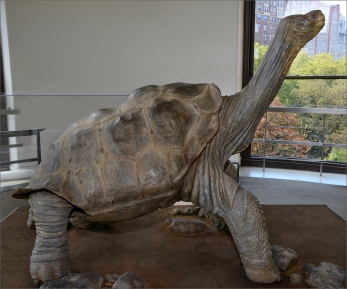American Museum of Natural History Unveils Iconic Galapagos Tortoise ‘Lonesome George’ on Exhibit
by Tom Edathikunnel
The Museum of Natural History unveiled its latest specimen this week, showcasing Lonesome George, the final member of the now extinct species of Pinta Island tortoise. Set amid the spectacular fossils in the museum’s Hall of Primitive Mammals, this tortoise stands as a challenging reminder of the fragility of life and present need for conservation. As the last of his species, Lonesome George maintains his hold of deep wonder, demonstrating the immediate environmental impacts of human indifference and ignorance.
Weighing 165 pounds, measuring 5 feet long, and living for over 200 years, Lonesome George (Chelonoidis abingdoni) offered scientists a unique look at a species long thought extinct. In the early 1900’s this species of giant Galapagos tortoises were thought to have vanished due to centuries of over hunting for meat and oil. However George was a surprise discovery, stumbled upon by a Hungarian scientist in 1971.
The larger symbolic nature of George continues to ripple outward, motivating naturalists and conservations across the planet. The Galapagos islands are interesting in there isolation, leading to a myriad of species which have evolved a wide variety of adaptations. These islands were once home to more than 200,000 tortoises comprising of 14 different species. Of these vast numbers, four species have gone extinct in the last 200 years.
This rapid destruction is large in part due to the over hunting of man and the introduction of foreign species to this isolated ecosystem. With reflection and a deeper understanding of the relationship of flora and fauna, humanity can take the practical steps toward sustainable development, balancing the need to grow with a responsible allocation of resources.
Now preserved by Wildlife Preservation taxidermy expert George Dante, Lonesome George is now on display in impressive detail- from the missing toenail on his left foot to the grass stains on his neck. With this enormous effort to life like preservation and reconstruction, this individual will be a engaging display for Museum guests until January 4th, 2015.
Images courtesy of The Museum of Natural History.


